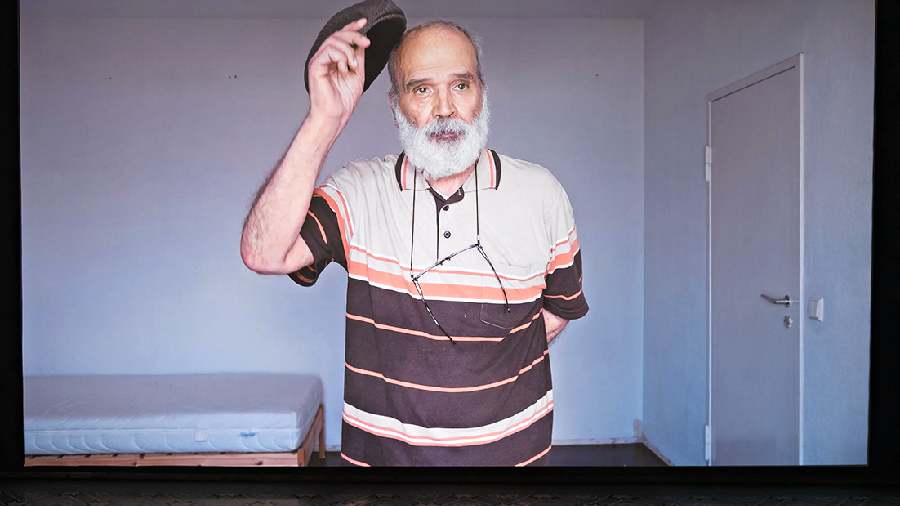The viewers were hooked from the first step in. From the gallery, at the far end, rose an insidious rumbling that erupted into insistent, hypnotic beats, the rhythms altering slightly: thhap, thhap, thhap. This was Matam, the Shia ritual of congregational lament for the Karbala martyrs with the vigorous beating of chests on Ashura. Bani Abidi’s sound installation reverberated through the entire floor at a recent presentation of Experimenter (Ballygunge Place), mingling, though distant and low, with the sounds of the video, The Song (also the name of the exhibition), running in another wing.
In a curious way, the two works offered contrasting metaphors. The intense, fervent, transformative invocation of collective mourning was a counterpoint to the mournful isolation of the protagonist in The Song. Connecting the two parts of a contentious narrative of identity and migration in the context of the Muslim ummah was persecution, which Abidi brought up in her other video, The Lost Procession, which is a weave of staccato vignettes about Pakistan’s minority Hazara community. Living their bleak, barren lives in the bleak, barren, rugged terrain of Quetta, Balochistan, in jostling houses in alleyways, and by high walls and martyrs’ graves under the watchful eyes of gun-toting security, they must contend with routine persecution, State surveillance, mysterious disappearances and occasional terrorist attacks.
Taking up the theme of the persecuted in different parts of the world, the film reminds viewers that Shia Lives Matter too. The Hazaras are, in fact, a “double minority” — or maybe triple, in terms of denomination, race and language: Shia and Turko-Mongol who speak Dari and Farsi. After a terrorist attack had killed several of them and they protested with the bodies, the Hazaras have been confined to safe zones, though people go missing from there too, memorialised here in large posters.
Many have escaped to a new refuge, Germany, which has become a welcoming haven for fleeing migrants, perhaps to atone for its racist past. A Muharram procession of Shias from different Islamic countries through the streets of Berlin had an electrifying sense of bonding beyond borders. But that’s only part of the story; the elegiac tone of The Song mocks the naïve romanticism of the title as it dwells on the utterly devouring loneliness of an elderly migrant in Austria, who’s Muslim but not, from his features, a Hazara. He mumbles prayers under his breath as the tape recorder plays the azan and fills his days with slow, deliberate motions and activity, inventing chores for himself: with odds and ends he makes devices that clatter and move to script the fiction of animated presences in an apartment of clinical anonymity.
The overbearing sense of loss and silence also permeates The Woman Who Talked Until She Disappeared. The dry wit of the title recalls the Victorian dictum — part of the Indian patriarchal standards of modest femininity — that girls should be seen and not heard. A montage of watercolour portraits of five South Asian women — one of them strikingly like Gauri Lankesh — was arranged in sequences of gradual fadeouts: they’d dared to speak up fearlessly against authority and the religio-cultural ethos that it nurtures and paid the price of protest.
Heroic masculinity, on the other hand, legitimises patriarchy. Abidi punctures its pomposity in the very title of another work: Reassuring Hand Gestures of Big Men, Small Men, All Men. A series of photographs excerpt the hands of leaders as they wave, show mailed fists, make a point or pray. Here’s the rhetoric of gestures that must boost the mythic aura around power as a psychological antidote to reality. How else would the lower orders be made to see monochromatic photocopies as Colour Plates?











